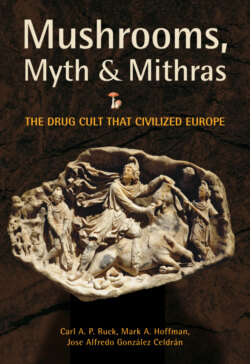Читать книгу Mushrooms, Myth and Mithras - Carl Ruck - Страница 14
На сайте Литреса книга снята с продажи.
Rapture
ОглавлениеJust as Mithras was the friend and ally of the Lord of Light, each initiate acquired him as the guide for his own ascent to the rim of the universe, to stand entranced in the presence of the living signs of the zodiac in the Empyrean. The Classical description of such a journey occurs in Cicero’s “Dream of Scipio,” his Stoic substitute for Plato’s eschatological myth of Er in the Republic.
And as I looked on every side I saw other things transcendently glorious and wonderful. There were stars which we never see from here below, and all the stars were vast far beyond what we have ever imagined. The earth itself indeed looked to me so small as to make me ashamed of our Empire, which was a mere point on its surface.
—Cicero, “Dream of Scipio”
The most advanced level of Mithraic initiation was experienced as a liberating spiritual rebirth.
Born at dawn on this twelfth day before the first of December. (Natus prima luce duobus Augg(ustis) co(n)s(ulibus) Severo et Anton(ino) XII k(alendas) Decem(bres) dies Saturni luna XVIII.)
—Graffito, Santa Prisca Mithraeum25
Mithras eventually ascended to heaven by feasting with the Sun on the hide of the slaughtered Bull. This sacred meal is almost as frequently depicted as the Bull-slaying in the Mithraea.
You have saved us with the eternal blood poured. (Et nos servasti eternali sanguine fuso.)
—Graffito, Santa Prisca Mithraeum26
The religion that had survived already for two millennia was syncretistic, incorporating elements of Mesopotamian and Hellenic symbolism. It was typical of the Classical world to recognize the deities of foreign nations as versions of their own gods. Thus the Mithraic Zoroastrian pantheon consisted of Ahura Mazda (related to the Vedic Mitra-Varuna, diad of the Vedas), who was equated with Zeus. His opposite, the force of darkness, was Ahriman, equated with Hades-Pluto. Kronos, the father of the first generation of Olympians, was often confused with Khronos, the figure of time personified, and equated with Zurvan. The Babylonian Shamash was seen as a version of Mithras and identified with the sun god Helios. Anahita, the sometime mother of Mithras (since he also had a motherless birth), was equated with Artemis, both of them associated with special springs or waters.
Although the origin of Mithras was Aryan, the impetus for much of the later mythology and ritual is still very much a matter of debate. Certainly Mesopotamian influences played a major role in brokering this religion to the Occidental world, as did the speculations of Hellenistic thinkers. The astronomical and alchemical aspects may be a Chaldean addition and may not go back to its earliest origins. The theme of ecstatic redemption through the sacramental meal is its essential feature, however, and was the most obvious way that the Soma-haoma rite reached the West. Surprisingly, this has been the feature usually least noticed by scholars, even for those who acknowledge that it was the sacramental meal of warriors. During the two thousand years that separate the Vedic Mithras from the Roman cult of the bull-slayer, the secret ritual practice underwent numerous mutations. Despite the changes, there is no doubt that its ethnic identity in the Roman Empire was recognized as Persian and the cult of the Magi priesthood.27
As intriguing as the problem of haoma/soma’s identification is, it does not contribute one way or the other to a religious understanding of the sacred juice…. A second major property of haoma/soma … was that of a stimulant taken by warriors before going into battle.
—W. Malandra.28
It did not really matter what Soma was, since it was lost so early in history.
—W. Doniger.29
Since there is so little documentation about Western Mithraism, it is extremely difficult to compare, contrast, and otherwise understand how the Western manifestation of Mithras is related to the Vedic and Persian pantheons. While there is no doubt that Mitra, Mithra, and Mithras are essentially the same deity, there are two schools of thought regarding the origin of Roman Mithraism.30 While some scholars argue for or against an independent Roman genesis, others, like ourselves, feel that there is ample evidence for both Aryan and Persian sources as well as distinctly Hellenistic and Roman innovations to the entheogenic ritual. An indisputable and well-documented connecting thread between the Eastern and Western Mithraic rites concerns the use of botanical sacrament. We argue that the visionary state induced by haoma is the essential and indispensible element to the Mithraic religion, whatever the particulars of its outward forms or cultural context, and that identifying the specific sacrament also informs the mythology and unanswered questions relating to the complex of metaphors expressed in the mythic narrative.
As ample evidence demonstrates, the mushroom-centered ritual survived in the West, as well as in the East, and was a fundamental element of the political and military power that upheld the far-flung Roman Empire. The very similar rites of early Christianity easily assimilated it, and it continued to survive in the so-called heresies throughout the medieval period, and also in the perpetuation of pagan knowledge in hermetic alchemy.
The entheogenic initiation was as fundamental to the formation of the pagan and Christian cultural identity and the political organization of civilized Europe as the similar experience afforded the Greco-Roman world in other Mystery initiations. Foremost among those experiences being the consciousness-altering ergot potion of the Eleusinian rites,31 as well as those like the Mystery of Osiris assimilated from Egypt. Even Cicero added his voice to the chorus of endorsements for Eleusis, which included most of the famous artists and leaders of Classical antiquity, claiming that there was nothing better that Athens had offered the world.
